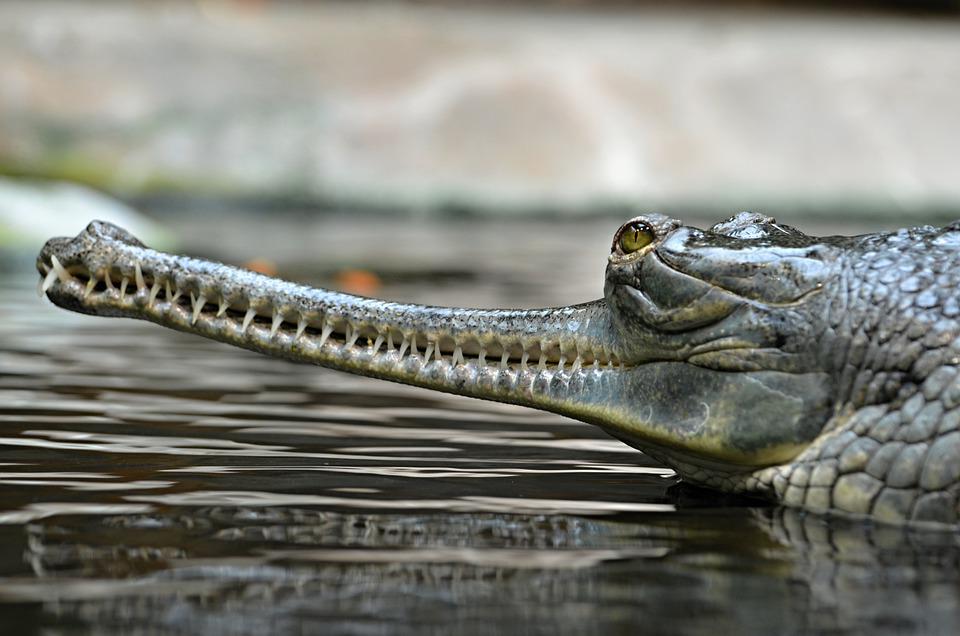India has been making significant progress in the conservation of keystone species like Tigers. This stands against the grain of thought that wildlife populations are plummeting in the world’s second largest population where 1.3 billion live.
Among the many conservation success stories to emerge from India recently, is the peculiar case of Indian Gharial (Gavialis gangeticus), a fish-eating crocodile belonging to the Gavialidae family.
Gharial: The Long Snouted Fish Eating Crocodilian
Gharials are characterized by a very long and narrow snout, with a distinct boss at the end of the snout. They live in freshwater river systems. Adult Gharials can be as long as 15 feet and can weigh over 2000 pounds. 
Since the Gharials cannot chew fish, they consume the whole fish or tear them apart into smaller pieces and consume them. Gharials are among the very few species which occasionally consume stones as “gastroliths”. Gastroliths are stones that are held inside a gastrointestinal tract or muscular gizzard by the animal to aid digestion and regulate buoyancy. It is found usually in animals (like gharials) which lack suitable grinding teeth.
During the past 100 years, the population numbers of Gharials dwindled rapidly due to loss of its primary habitat and poaching along the river banks of northern India. There was a 98% decline in population between 1946 and 2006. IUCN has categorized Gharials as critically endangered (CR).
However, the numbers are now coming up, thanks to conservation efforts. The hard work put in to revive the population numbers are worthy to be highlighted.
Revival in Difficult Terrains
Close to the Indo-Nepal border, in the state of Bihar, runs the river of Gandak. Once teeming with gharial population, their population declined and they were declared as near extinct. A 2010 survey revealed the presence of just 15 gharials in 2010.
Following this, in 2014, the Wildlife Trust of India and Bihar Forest Department initiated the gharial reinforcement project. The project would target the conservation of gharials through multiple measures including fitting of trackers (satellite transmitters and VHF tags), reintroduction programs, partnership with local fishermen, and strict conservation policies.
As a result, the gharial numbers increased dramatically. In 2018, 211 gharials were recorded in the survey and the river now hosts the second highest population of gharials in India.
The reintroduction and successful breeding of gharial in Gandak river can be considered relatively easier when compared to other more difficult reintroduction projects like those in Punjab where they went completely extinct.
Reintroduction into Extinct Territories
The rivers in the state of Punjab hosts some of the ideal habitats for Gharial. In fact, until the 18th century Gharials were abundant in Punjab. Loss of habitat and poaching resulted in rapid depletion of population and gharials went extinct in Punjab.
Today, Gharial captive breeding programs in the states of Uttar Pradesh and Madhya Pradesh have successfully bred Gharials, and are now introducing juveniles into Punjab’s Beas river.
The Beas river is 292 miles long and has a drainage basin of 7839 square miles, an ideal habitat for the juveniles to mature into adults and breed. B.C. Choudhury, an expert on the gharial conservation, indicated that the gharials have adapted well to the new environment and is hopeful that they will start breeding in another 5 years.
But reintroduction of Gharials in Punjab was not easy. Grassroot awareness programs had to be conducted to help farmers understand that the gharial is not a predator that attacks humans or animals, as it feeds mostly on fishes, and sometimes on turtles.
Besides, in order to make sure that their habitat is not disturbed, the Punjab government declared the Beas river (115 miles of it in Punjab) as a conservation reserve. It was the first time that a river was declared as a protected reserve in India, indicating the determination from authorities to conserve gharials and a couple of other species in the river stretch that fall under the threatened, vulnerable and endangered category of IUCN.
The recent conservation success of gharial is a testament to how rehabilitation programs, captive breeding, and careful reintroduction measures can bring back to life species that are at the brink of collapse.
The notion that wildlife species are spiraling out of control into extinction is not true. Across the globe, we have had conservation programs that have helped in the revival of various species.
